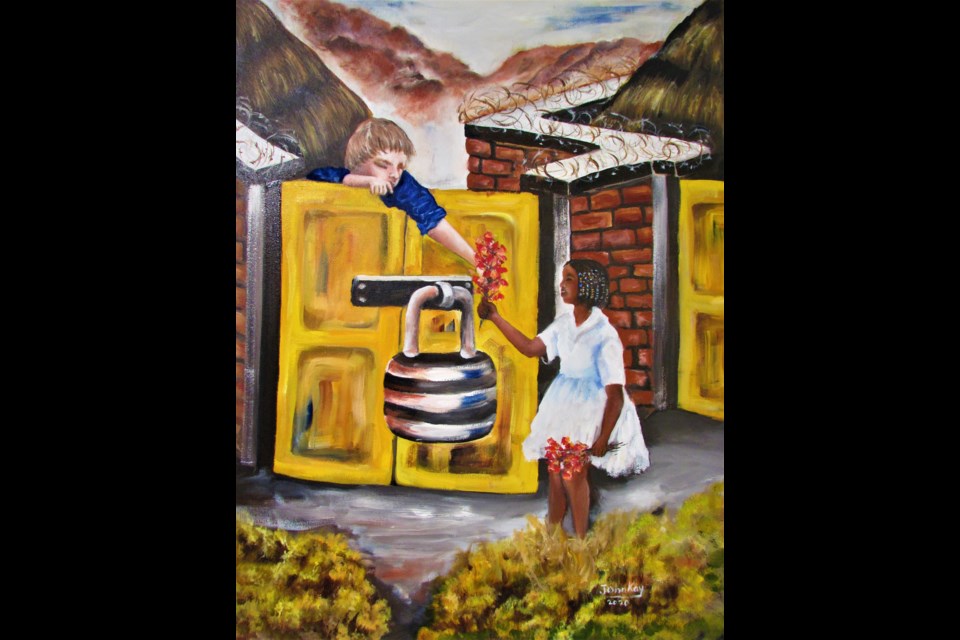DETAILS
Love Thy Neighbour
Featuring artworks by Elsa Robinson and John Kayinamura
Opening reception on Saturday, Feb. 1, from 1 to 3 p.m. The event will feature a diverse array of family-friendly programs including a hands-on art activity, African dance performance, and a talk by Owen Fregene of Reez. Artists will be in attendance.
Until Saturday, Feb. 29
Art Gallery of St. Albert
19 Perron St. Call 780-460-4310 or visit artgalleryofstalbert.ca for more information.
Love thy neighbour. We all know this phrase and its importance to spiritual practice and in good community living in general. Now, it’s the title of the new exhibit at the Art Gallery of St. Albert. It’s also the cultural institution’s first exhibition marking Black History Month as a way to recognize, honour and celebrate the achievements of black people.
The moment couldn’t have been better accomplished than with the contributions of John Kayinamura and Elsa Robinson. Rwanda-born Kayinamura opened his own gallery in Kigali in 1995 but then migrated to this country nearly a decade later. Now an Edmonton resident, his Realist oil works reflect not only his memories of his homeland but also his views on the history of race relations in this world.
“Before, people created boundaries because of physical differences. New generations have come, and they have made changes. They have reached beyond the boundaries to make this world better,” he explained in an artist’s statement.
Robinson has primarily been using mixed media collage to explore metaphors that “address identity, spirituality, culture and present positive images and positive messages for the community.” The Jamaican-Canadian artist explained positivity and spirituality are the keys to the future of the world.
“The theme is ‘love thy neighbour’ as a response to racism. Of course, my approach is always more solution-driven than to express problems all over again,” she began.
For her contribution, the artist and art educator developed new works that have long lingered on her to-do list: a limited colour palette. If you aren’t already familiar her artwork, a quick visit to the gallery on her website at elsarobinson.com will explode onto your computer screen with brilliant and saturated colours from every stripe and corner of the spectrum. A lot of these works are biographical by her own admission as well.
For Love Thy Neighbour, she poignantly and deliberately limited herself to two colours, one of which is black. She contributed only four works to the show – Black Paintings I through IV – to draw attention to colour choice and how people react to it.
“The reason I did that is that it's trying to address people's attitude to blackness in two ways,” she continued, noting black’s use as a colour and as a symbol. The other colour isn’t white, by the way. It’s gold, which still makes for a striking contrast with the black.
But don’t be content to give each piece a quick glance. Robinson invites you in for a closer look. You won’t be disappointed in doing so.
“Within the black there are different tints and shades of black. In other words, when you look upon or when you name a person black, it doesn't tell you anything much more than what their physical looks might be. It doesn't tell you anything about the person. Using an image that has a lot of different shapes and textures of black is basically saying that there's no one thing if you're looking at labelling even fabric, but if you take it as far as people then it simply is a colour. That's all it is in that straight-up way.”
The paintings are black, she added, because she wants people to come to the paintings to come and look in the same way that she wants them to look at people who have been labelled as black or any other colour.
“Come closer to look at what is actually there, and try to understand what you're actually looking at. In the paintings, it's looking at the textures or looking at what the painting is saying. If you stay far from the painting, you may see just black and gold but then the closer you get to the painting is the more you start to see the detail of what that painting is all about. My idea is it's the same thing that when you look at a person. As far as racism goes, we need to get past labelling people a colour and start to find out who these people are as people.”




